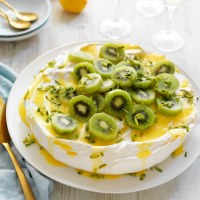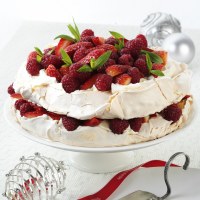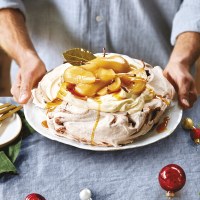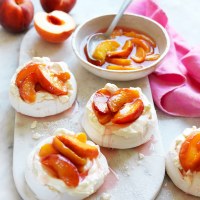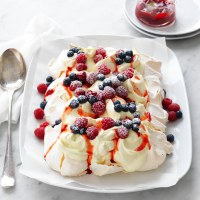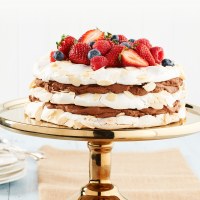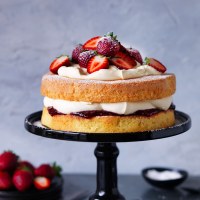Tips for making the best pavlova
Pavlova is a classic Aussie dessert that bakers around the country start whipping up right around Christmas and summertime. It's a real crowd pleaser with its light, crisp base and lashings of cream and fruit, and loved by hosts and guests alike because it's easy to make and even easier to eat.
As long as you follow these tips, there's no need to fret about under-whipped egg whites, sunken tops or weeping cracks. Take note and making your pav will be a breeze!
Classic pavlova recipe
INGREDIENTS
- 6 egg whites (210g), at room temperature
- 330g (1½ cups) caster sugar
- 1½ teaspoons white vinegar
METHOD
- Preheat oven to 150°C fan forced. Mark a 23cm circle onto a sheet of baking paper. Turn baking paper over and place onto an upturned large greased baking tray (this makes it easier to slide the pavlova off the tray once cooked).
- Place egg whites in the bowl of an electric mixture. Whisk on high speed until stiff peaks.
- Gradually add sugar a tablespoon at a time, making sure sugar is dissolved between each addition. Once sugar is added, scrape down sides of bowl if needed. Whisk for a further 6 minutes, or until mixture is thick and glossy.
- Add vinegar and whisk for further 2 minutes. Spoon meringue onto paper. Use a pallet knife to shape the meringue into peaks.
- Place in oven, reduce oven temperature to 120°C fan forced and bake for 1 hour or until dry. Turn off oven and allow pavlova to cool completely. Meanwhile, you can make lemon curd with the leftover egg yolks.
Get the recipe you can save to your myfoodbook cookbooks: Classic Pavlova with Lemon Curd and Kiwi Fruit
Pavlova Facts and Tips
Can you use old eggs for meringue?
Use the freshest eggs possible. Fresh eggs create a better foam than older eggs. They're more acidic, which allows proteins to knit together tightly making a more stable foam. Frozen (and defrosted) egg whites are a good option too, as long as they were frozen while fresh. You can still use older egg whites, but the meringue won't be as stable and may take more time to whip.
Are cold or room temperature eggs better for pavlova?
Room temperature egg whites will create a more stable and airier meringue. Remove eggs from fridge 30-60 minutes before using. Eggs are easier to separate when cold, so you can separate the eggs first then let them come to room temperature.
What type of sugar do you use in meringue?
You can use either white or caster sugar for meringue, but caster sugar is easier to use. It has smaller crystals, therefore dissolves more quickly and easily into the egg whites. For a successful pavlova, the sugar must be completely dissolved into the egg whites. To check this, rub some of the meringue between your finger and thumb, it should feel smooth. If it feels grainy, keep beating until it's smooth.
Fat is the enemy of meringue
Any fats and oil left on your equipment will stop your egg whites from frothing up and making a good meringue. If possible, use a glass or stainless-steel mixing bowl that can be cleaned thoroughly. Avoid plastic mixing bowls as they tend to cling onto fats and oils.
Ensure your bowl and beaters are spotless by washing in hot soapy water. You can also wipe them down with white vinegar before adding the egg whites.
Egg yolks contain fats, so avoid getting any of it into your whites while separating the egg. It's best to separate each egg individually, and add egg whites to the main bowl one at a time to avoid any trace of yolk.
Don't make pavlova on a humid day
Pavlova is high in sugar, which absorbs moisture from other ingredients and the atmosphere.
Making a meringue on a very humid day can result in a weeping, soft or sticky pavlova. To reduce the chance of this happening, use a recipe that uses cornflour in the meringue base. Also ensure the pavlova cools completely in the oven with the door ajar after baking. Once cool, transfer to an airtight container and store in a dry pantry or cupboard. Don't store pavlova in the same container as other baked goods, as it will absorb their moisture.
For more stable pavlova, add cornflour and acid
Adding these key ingredients in the correct amount creates a more stable egg white foam and this in turn helps prevent potential problems. Cornflour is used to stabilise the egg whites during baking which reduces the possibility of the pavlova weeping. A rough guide is to use a small amount, approx. one teaspoon per egg white. Too much cornflour will give your pavlova an unpleasant chalky texture.
Adding a little acid such as white vinegar, lemon juice (about 1 teaspoon for every 4 egg whites) or cream of tartar (about ½ teaspoon per 4 egg whites) is another method of ensuring that your pavlova foam is less likely to collapse from overbeating.
What speed should you whisk the egg whites?
If using a stand mixer, always use the whisk attachment as this will incorporate the most amount of air. Start the mixing at medium to medium-high speeds, moving up to high speed as the egg whites get frothy. These speeds create an egg white foam of tiny even bubbles that is easy to shape as a pavlova.
When should you start adding sugar to the egg white?
Adding sugar at the beginning will double the amount of time it takes to whip the egg white to a foam. Instead, whisk egg whites at least until it reaches soft peaks before adding sugar. To determine whether you are at soft peaks, turn your whisk upside down, the peaks should just hold their shape for a few seconds, only to melt back into the egg white foam.
Why do you have to add sugar to meringue gradually?
Gradually adding sugar allows it to dissolve into the egg white. As a general guide, add a large spoonful every 1 minute to 1½ minutes, whisking well between each addition. This is enough time to dissolve the sugar crystals. To check that the sugar has dissolved, rub a little of the mixture between your fingers – if any grittiness remains, continue whisking for a further minute and test again until the mixture is smooth.
Adding sugar too slowly will create large air pockets and a mixture that is too airy and foamy. Neither are ideal for a pavlova with a good texture.
How to shape a pavlova
- Draw a circle to mark out the size of the pavlova onto a sheet of baking paper.
- Cover a flat oven tray with low or no sides with baking paper. Grease the tray lightly to hold the paper.
- Mound the pavlova mixture in the centre of the oven tray. Spread it out to the size of the marked circle. Use a spatula to smooth the mixture as it spreads.
- For a sturdier shape, keep the height no higher than 5-6cm. Flatten the top to create a space for the cream and fruit to fill.
Why do you need to cook meringue at two temperatures?
Always follow recipe instructions for cooking temperatures. Use a conventional oven only. Preheat at a higher temperature (150°C). This helps to create a thick crust that stabilises the pavlova. Reduce oven temperature to 110-120°C when you add the pavlova. Bake for the amount of time in the recipe without opening the door to peek. At the end of the cooking time, turn oven off, prop the door ajar and leave inside to cool.
How to store pavlova
Store cooled pavlova in an airtight container until ready for serving. Don't store it with other baked goods, as it will absorb their moisture and soften. Do not refrigerate, as this will cause it to sweat when it comes to room temperature, softening the crisp meringue shell. Decorate your pavlova just before serving. It will hold for 20-30 minutes.
How long can you keep pavlova
You can store pavlova in an airtight container for up to 2 days. Any longer and it may not be as crisp and light as when it was freshly baked.




